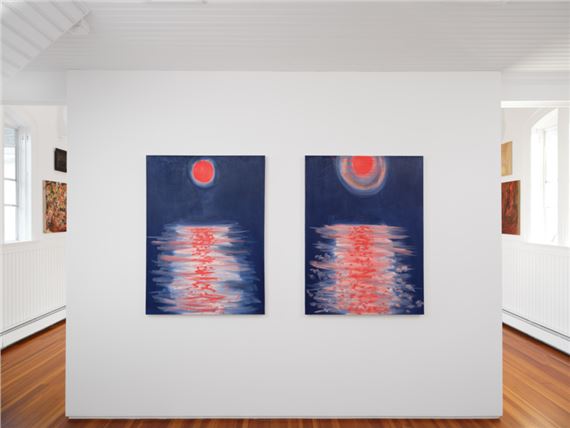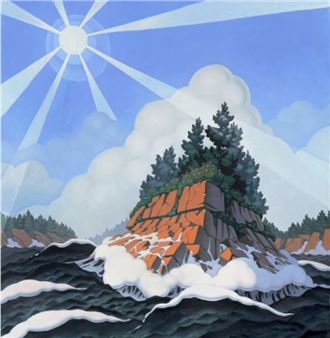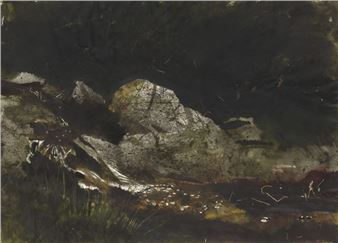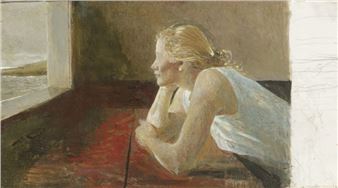A Certain Form of Hell
As above, so belowвҖ”every vision of heaven is mirrored by a depiction of hell. Paintings of the Last Judgment throughout the millenia, from Jan van Eyck to Michelangelo to William Blake to Buddhist Mandalas, set the two realms in relation, representing moral consequences as a dichotomous, mutually enabling pair. Inspired by DanteвҖҷs Inferno, the counterpart to the Italian poetвҖҷs Paradiso, artists like Sandro Botticelli and Gustave DorГ© have attempted to map hellвҖҷs nine circles, charting its strata from the EarthвҖҷs crust down into its core. Following A Particular Kind of Heaven, last yearвҖҷs exhibition sited in Ann CravenвҖҷs deconsecrated church in Maine, Karma presents A Certain Form of Hell. Titled after a 1983 Ed Ruscha painting just like its predecessor, the exhibition features works exploring the netherworld in its many manifestations.
Warming, cleansing, life-givingвҖ”fire is also the archetypal symbol of hell. Milton AveryвҖҷs Charred Forest (1939) shows its ashy aftermath in the Canadian GaspГ© Peninsula, where he spent a formative summer developing the luminous planes of color that would define his mature style. While AveryвҖҷs painting suggests both destruction and the promise of rebirth, Mungo ThomsonвҖҷs Wildfire (June) (2021) shows the blaze still raging, its flames illuminated by an LED lightbox. The absence of light can also be hellish, as in the windows opening out onto a black void in Henni AlftanвҖҷs Darkness (2024) or the door to nowhere in Hughie Lee-SmithвҖҷs The End (The Pink Door) (1998). Cecily BrownвҖҷs Wee Hell (2025) also transcends fiery hues, instead taking cues from Old Master treatments of the underworld and translating them into a kaleidoscopic inferno of whirling brushstrokes.
Other artists draw our attention to the sinister underbellies of supposedly neutral objects and places, probing our cultural unconscious. Martin WongвҖҷs Eye of Providence (1975) riffs on the design of the US dollar bill, highlighting the cleaved pyramid that some believe symbolizes malevolent secret societiesвҖ”namely, the Illuminati. Mathew CerlettyвҖҷs photorealist, oil-on-linen Ribeye (2025) crops in on two glistening slabs of meat, industrially packaged and ready for consumption. Jane DicksonвҖҷs LV 82 Casino Girls Red Felt (2021), painted on a blood-red swath of the titular textile, depicts figures transfixed by the glow of slot machines, suspended in some self-inflicted purgatory. Leonora CarringtonвҖҷs graphite drawings of Parisian street scenes find hell, as Jean-Paul Sartre famously quipped, in вҖңother people.вҖқ Mike KellyвҖҷs darkly humourous Length (1985) implies that the male psyche is an underworld all its own.
Hell can be abstract, as immaterial and wrenching as a feeling. Viennese Actionist Hermann NitschвҖҷs Rovereto VI 64.Malaktion (2012) is visceral, its ridges of scarlet paint manipulated with the artistвҖҷs fingers during one of his gory performances. Peter BradleyвҖҷs Nix Olympia (1973), its colors applied via spray gun, appears not bodily but mineral, like lava roiling out of the depths. The crimson ground of Richard MayhewвҖҷs phosphorescent Untitled (Abstract Composition) (1975) is horizontally bisected by a blue current, the work reads as both landscapeвҖ”perhaps the banks of the River StyxвҖ”and color field. Comprising nine perfect circles excised from silver cardboard, Cady NolandвҖҷs (Not Yet Titled) Parkett 46 (1996) conveys the violence of a stockade from geometry alone. While this form of torture is medieval, NolandвҖҷs evocation of the burning shame of public humiliation resonates in a contemporary culture intimately familiar with the spectacle of suffering. If, as Dante wrote, вҖңthe path to paradise begins in hell,вҖқ a consideration of the underworld is a necessary evil.

Recommended for you
As above, so belowвҖ”every vision of heaven is mirrored by a depiction of hell. Paintings of the Last Judgment throughout the millenia, from Jan van Eyck to Michelangelo to William Blake to Buddhist Mandalas, set the two realms in relation, representing moral consequences as a dichotomous, mutually enabling pair. Inspired by DanteвҖҷs Inferno, the counterpart to the Italian poetвҖҷs Paradiso, artists like Sandro Botticelli and Gustave DorГ© have attempted to map hellвҖҷs nine circles, charting its strata from the EarthвҖҷs crust down into its core. Following A Particular Kind of Heaven, last yearвҖҷs exhibition sited in Ann CravenвҖҷs deconsecrated church in Maine, Karma presents A Certain Form of Hell. Titled after a 1983 Ed Ruscha painting just like its predecessor, the exhibition features works exploring the netherworld in its many manifestations.
Warming, cleansing, life-givingвҖ”fire is also the archetypal symbol of hell. Milton AveryвҖҷs Charred Forest (1939) shows its ashy aftermath in the Canadian GaspГ© Peninsula, where he spent a formative summer developing the luminous planes of color that would define his mature style. While AveryвҖҷs painting suggests both destruction and the promise of rebirth, Mungo ThomsonвҖҷs Wildfire (June) (2021) shows the blaze still raging, its flames illuminated by an LED lightbox. The absence of light can also be hellish, as in the windows opening out onto a black void in Henni AlftanвҖҷs Darkness (2024) or the door to nowhere in Hughie Lee-SmithвҖҷs The End (The Pink Door) (1998). Cecily BrownвҖҷs Wee Hell (2025) also transcends fiery hues, instead taking cues from Old Master treatments of the underworld and translating them into a kaleidoscopic inferno of whirling brushstrokes.
Other artists draw our attention to the sinister underbellies of supposedly neutral objects and places, probing our cultural unconscious. Martin WongвҖҷs Eye of Providence (1975) riffs on the design of the US dollar bill, highlighting the cleaved pyramid that some believe symbolizes malevolent secret societiesвҖ”namely, the Illuminati. Mathew CerlettyвҖҷs photorealist, oil-on-linen Ribeye (2025) crops in on two glistening slabs of meat, industrially packaged and ready for consumption. Jane DicksonвҖҷs LV 82 Casino Girls Red Felt (2021), painted on a blood-red swath of the titular textile, depicts figures transfixed by the glow of slot machines, suspended in some self-inflicted purgatory. Leonora CarringtonвҖҷs graphite drawings of Parisian street scenes find hell, as Jean-Paul Sartre famously quipped, in вҖңother people.вҖқ Mike KellyвҖҷs darkly humourous Length (1985) implies that the male psyche is an underworld all its own.
Hell can be abstract, as immaterial and wrenching as a feeling. Viennese Actionist Hermann NitschвҖҷs Rovereto VI 64.Malaktion (2012) is visceral, its ridges of scarlet paint manipulated with the artistвҖҷs fingers during one of his gory performances. Peter BradleyвҖҷs Nix Olympia (1973), its colors applied via spray gun, appears not bodily but mineral, like lava roiling out of the depths. The crimson ground of Richard MayhewвҖҷs phosphorescent Untitled (Abstract Composition) (1975) is horizontally bisected by a blue current, the work reads as both landscapeвҖ”perhaps the banks of the River StyxвҖ”and color field. Comprising nine perfect circles excised from silver cardboard, Cady NolandвҖҷs (Not Yet Titled) Parkett 46 (1996) conveys the violence of a stockade from geometry alone. While this form of torture is medieval, NolandвҖҷs evocation of the burning shame of public humiliation resonates in a contemporary culture intimately familiar with the spectacle of suffering. If, as Dante wrote, вҖңthe path to paradise begins in hell,вҖқ a consideration of the underworld is a necessary evil.
Artists on show
- Adam Alessi
- Aleksandra Waliszewska
- Alex Da Corte
- Alex Katz
- Andrew Cranston
- Ann Craven
- Arthur Simms
- Aubrey Levinthal
- Betsy Eby
- Bo Bartlett
- Borna Sammak
- Brett Bigbee
- Cady Noland
- Calvin Marcus
- Carole Vanderlinden
- Casey Bolding
- Cecily Brown
- Dike Blair
- Emilie Stark-Menneg
- Friedrich Kunath
- Gertrude Abercrombie
- Hadi Fallahpisheh
- Henni Alftan
- Hermann Nitsch
- Hughie Lee-Smith
- Ian Felice
- Jacob Littlejohn
- James Prosek
- Jane Dickson
- Jay Stern
- Jeremy Frey
- Jonas Wood
- Katherine Bradford
- Kathryn Lynch
- Kathy Butterly
- Katie Hargrave
- Keith Mayerson
- Kye Christensen-Knowles
- Laura Owens
- Lee Lozano
- Leonora Carrington
- Lois Dodd
- Louise Bourgeois
- Lucy Bull
- Luigi Zuccheri
- Luisa Rabbia
- Maja Ruznic
- March Avery
- Marian Spore Bush
- Mark Milroy
- Marley Freeman
- Martin Wong
- Mathew Cerletty
- Matthew Tully Dugan
- Melanie Essex
- Mia Kokkoni
- Mike Kelley
- Milton Avery
- Mungo Thomson
- Nancy Diamond
- Nathaniel Oliver
- Nicole Eisenman
- Nicole Wittenberg
- Norman Zammitt
- Ouattara Watts
- Peter Bradley
- Phoebe Derlee
- Phoebe Helander
- Randy Wray
- Reggie Burrows Hodges
- Richard Mayhew
- Rudolf Stingel
- Sam McKinniss
- Sanaa Gateja
- Sean Cavanaugh
- Seth Becker
- Sterling Ruby
- Tabboo!
- Tamo Jugeli
- Tatsuo Ikeda
- Tom Burckhardt
- Tristan Unrau
- Ugo Rondinone
- Ulala Imai
- Wade Guyton
- Woody de Othello
- Xiao Jiang
Related articles
As above, so belowвҖ”every vision of heaven is mirrored by a depiction of hell.
From exalted to excommunicated, вҖңA Certain Form of HellвҖқ is the New York galleryвҖҷs follow-up to last yearвҖҷs вҖңA Particular Form of HeavenвҖқ at a deconsecrated church in Thomaston, Maine.

 ARTISTS
ARTISTS
















